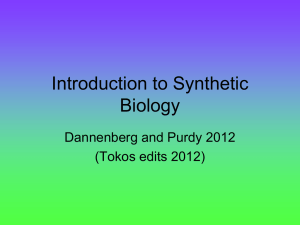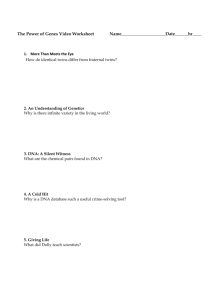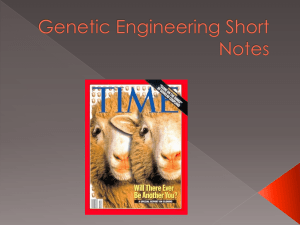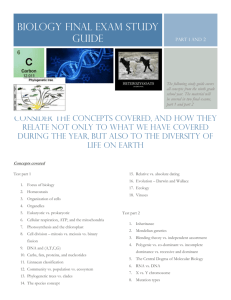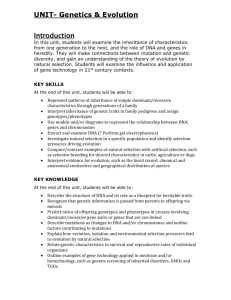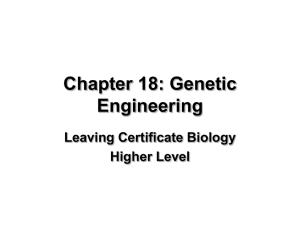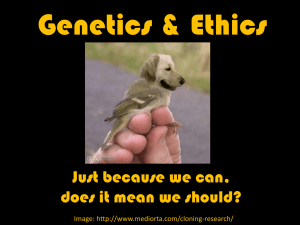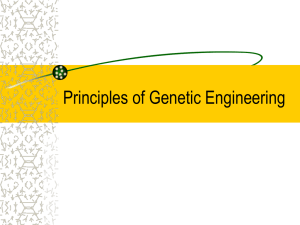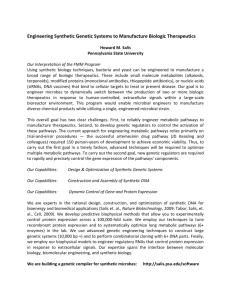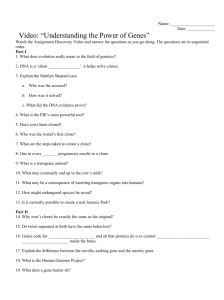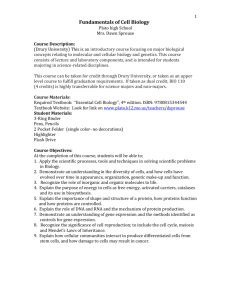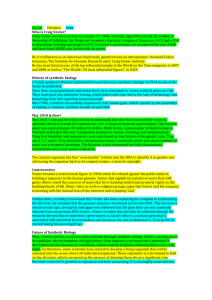htgaa - BUGSS
advertisement
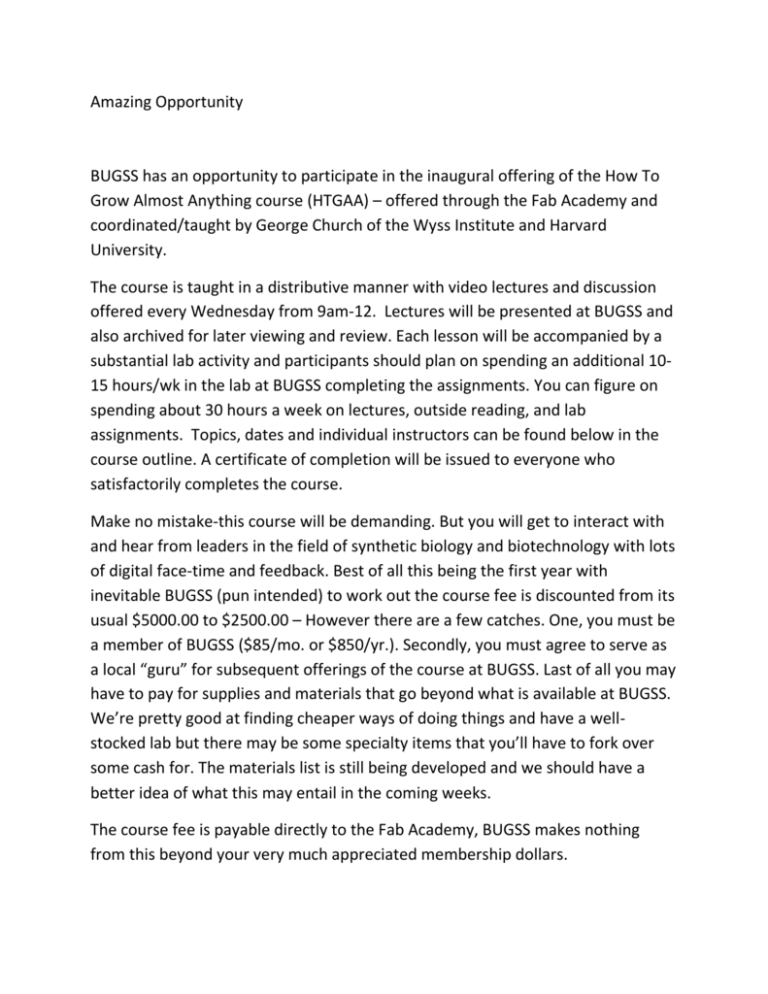
Amazing Opportunity BUGSS has an opportunity to participate in the inaugural offering of the How To Grow Almost Anything course (HTGAA) – offered through the Fab Academy and coordinated/taught by George Church of the Wyss Institute and Harvard University. The course is taught in a distributive manner with video lectures and discussion offered every Wednesday from 9am-12. Lectures will be presented at BUGSS and also archived for later viewing and review. Each lesson will be accompanied by a substantial lab activity and participants should plan on spending an additional 1015 hours/wk in the lab at BUGSS completing the assignments. You can figure on spending about 30 hours a week on lectures, outside reading, and lab assignments. Topics, dates and individual instructors can be found below in the course outline. A certificate of completion will be issued to everyone who satisfactorily completes the course. Make no mistake-this course will be demanding. But you will get to interact with and hear from leaders in the field of synthetic biology and biotechnology with lots of digital face-time and feedback. Best of all this being the first year with inevitable BUGSS (pun intended) to work out the course fee is discounted from its usual $5000.00 to $2500.00 – However there are a few catches. One, you must be a member of BUGSS ($85/mo. or $850/yr.). Secondly, you must agree to serve as a local “guru” for subsequent offerings of the course at BUGSS. Last of all you may have to pay for supplies and materials that go beyond what is available at BUGSS. We’re pretty good at finding cheaper ways of doing things and have a wellstocked lab but there may be some specialty items that you’ll have to fork over some cash for. The materials list is still being developed and we should have a better idea of what this may entail in the coming weeks. The course fee is payable directly to the Fab Academy, BUGSS makes nothing from this beyond your very much appreciated membership dollars. This course is really about developing the local “gurus” to teach subsequent courses. As such you should probably have a pretty good foundation in biology but there are no “prerequisites” and you’ll find plenty of coaching and resources at BUGSS to fill in any gaps in your knowledge base. Tentative Course Schedule: Principles and Practices, Content management - 26 August 2015 Assignment: List at least one highly desirable project that seems to you at this point within range for HTGAA and one which is just beyond. Neil / David / George / JMM Computer-aided design - 2 September 2015 Software for primer design, DNA fundamentals and folding (caDNAno.org). Assignment: Design a 3D DNA nanostructure. o Will Shih (Wyss Institute) Bio design - 9 September 2015 Building DNA from parts. Genetic circuits. Assembly biochemistries: ligation, biobricks, golden gate, Gibson. Assignment: Build a genetic circuit. o George Church OR Jim Collins (/ Chris Voigt (MIT)) Bio production - 16 September 2015 Organism engineering for bio-manufacturing. Pathway design. Case studies: Gen9 (DNA assembly), Gingko (high-value chemicals), Amyris (biofuels). Assignment: Design a pathway for manufacturing a biomolecule. o Barry Canton & Reshma Shetty (Gingko BioWorks) Computer-controlled machining - 23 September 2015 DNA assembly from high-density biomolecule arrays. Inputs: CustomArray DNA microarrays, Agilent oligonucleotide pools, spotted microscope slides. Assignment: Build a gene or genetic circuit from DNA arrays (oligonucleotides or parts). o To find replacement (Sri Kosuri (UCLA)) Controlled cutting - 30 September 2015 CRISPR cutting and genome editing. Gene drives, population-level genome changes by CRISPR. Assignment: Design a gene drive and a reversal drive. Plate yeast spores to show 2:2 (normal) or 4:0 (gene drive) red vs white colonies. o Kevin Esvelt (Wyss Institute) 3D scanning – 7 October 2015 Fluorescent in situ sequencing (FISSEQ). Assignment: Sequence a genetic circuit. o Evan Daugharthy + George Church (Wyss Institute) Synthetic development biology (organoids on chips) - 14 October 2015 Synthetic organs on chips. Variations: gut, lung, liver, brain. Assignment: Design a synthetic organ. o Nina Tandon (Epibone) & David Kong (MIT) Molding and casting - 21 October 2015 3D Bioprinting, cell extrusion. Inputs: polymers, hydrogels, cells. Assignment: Print a component of your designed synthetic organ. o To find replacement (Jennifer Lewis (Wyss Institute)) Hod Lipson? Input devices - 28 October 2015 Sensor - Selectors – chemicals, photochemistry. Sensor design and fabrication. Assignment: Build a biomolecule sensor and measure something. o Srivatsan Raman (UW Madison) Composites - 4 November 2015 Hybrids – bio-inorganics (shells, bones, semiconductors) Assignment: http://www.biofaction.com/synthethic/?p=44 http://www.pnas.org/content/103/15/5652.full.pdf o Angie Belcher? Output devices - 11 November 2015 Neuromuscular, controlled replication Assignment: Use human stem cells to make contractile cardiac tissue “motor” o Kit Parker (Wyss Institute) Networking and communications - 18 November 2015 Highly parallel vs multiplexed I/O. Case study: microbial ecosystems and the human micro biome. Population dynamics, cell communication. Assignment: Design and implement a cellular behavior requiring cell communication and observable in a population. o To find replacement (Harris Wang (Columbia)) Adam Arkin? Peter Carr? Mechanical design, machine design - 25 November 2015 Automation tools for biology, from desktop biofabs (microfluidics and liquid handlers) to foundries and outsourcing (Transcriptic, Emerald Biosciences). Assignment: Design a tool chain for biological protocols. o David Kong (MIT) Interface and application programming - 2 December 2015 Synthetic ecosystem engineering. Darwinian competition and extinction. Assignment: Build a glass ecosphere. o Pam Silver? Dan Mandell? Applications and implications - 9 December 2015 Multi-virus resistance, Chemical production optimization. Assignment: Use one round of MAGE to evolve higher lycopene or indigo production (colony color). o To find replacement (Harris Wang (Columbia)) Alicia Jackson? Nili Ostrov? Invention, intellectual property, and income - 16 December 2015 Bio-Nano Fab similar to Macro Fab Assignment: What is the significance of http://bit.ly/1MnOIO7 “the whole cycle could be repeated”? Including Policy / Responsible Innovation? o George + Neil + David? Final Project Presentations For more information on the Fab academy and HTGAA contact: htgaadmin@fabacademy.org
